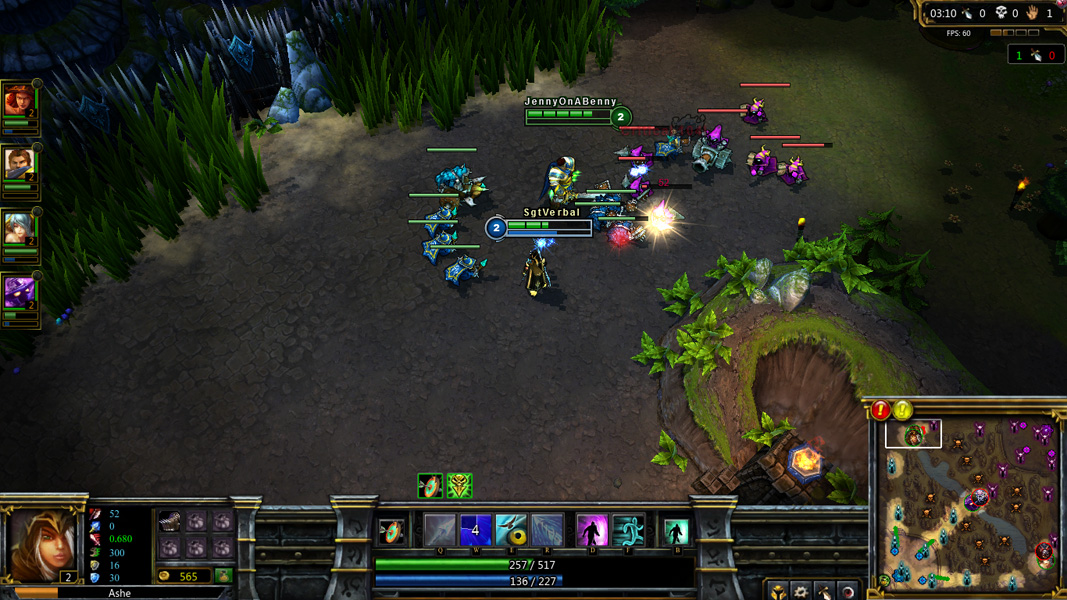First Impressions: League of Legends
League of Legends. Riot Studios, October 2009.
Born from the Warcraft 3 Mod "Defense of the Ancients," the immense popularity of the game was not lost on its creators. Blizzard's TOS for the WC3 map editor ensured that Blizzard would reap any and all profits made by a product of that engine. Thus, League of Legends was born in its own engine, and with its own company. It has been... well it has been a remarkable success, for a variety of reasons, some more notorious than others.
The game's most important design idea is its deep but narrow character balance. With great innovation, the developers are able to consistently produce playable characters who are new and exciting, and yet designed on just a slim few axes of balance. Needless to say, that balance runs very deep. Most of the other design elements in the game augment that deep character balance, some more successfully than others.
REAL TIME TACTICS
Being derived from a Warcraft 3 mod, it should be no surprise that many of the real time strategy aspects of the game were preserved in its independent form. The standard Blizzard controls are largely maintained: left clicks are for selection and player actions and right clicks are for quick character actions. The character abilities are much more streamlined, although this results from there only being one character per match, and only four usable abilities per character. I found that my RTS experience translated fairly well to controlling my champion in the combat of LoL.

Technically the game isn't the strictest interpretation of real time tactics; there are accumulating resources of gold and experience, but those resources dont' allow for the construction of more units. Instead this resource is used in customizing your champion's powerups in a very standard action/RPG way. Because these two resources are acquired directly through successful combat encounters, the RTT mechanics never break down into a "closet macro" system.
If I had to find a fault in LoL, it would be the fact that the "lane game" is fairly uninspired. Choosing a lane is hardly a thorough tactical decision. There is rarely a scenario in which a clever tactical push in a different lane can really defeat an enemy team that wasn't already losing. Thus, the inability to make the smartest choice means that the game cannot be deeply tactical for a single player. Team composition and coordination do make the laning game a little more interesting, but only serious, permanent teams with lots of experience playing together will actually benefit. Single players touring the random arenas will face meaningful tactical situations infrequently.
NARROW CHARACTER STAT BALANCE
With 40+ characters in circulation, it would be difficult for any development team to provide freedom of choice among a large roster of characters. What really impresses, however, is how varied the champions in LoL can be when they boil down to three primary attributes whose combinations make up the balance of the game. These three attributes are durability, DPS, and speed. Each attribute is delivered much more complexly than an RTS player might expect; this is where the RPG elements shine.
Armor and HP accomplish the same thing; they allow a champion to endure longer while taking damage. By proxy, healing and buffs do the same. In fact, debuffs applied to the other team increase durability just as much as armor, HP, or healing--if used properly. All of this is endurance, although some of it counterintuitively so.
DPS, or damage per second, is something that has been studied exhaustively in any game where it is a known concept. In LoL, however, there's an important second time scale. It's important to know how many damage per second one's champion can output, but it's equally important to know how long they can make it last. Thus, a nuker or assassin who doesn't get the job done in the first few seconds knows that it's time to disengage from the encounter.
Engagement and disengagement, and all their tactical applications are a function of speed. Thus, the application of DPS or the salvaging of poor or depleted durability are all a function of speed, as are many other points of tactical nuance, such as they are in the game.
META-LEVEL
Player profiles (each player is called a "summoner") can also level up. There are two resources gained at the end of each battle: summoner experience and influence points. These two resources are exchanged for basically the same thing: permanent power. Summoner experience is used to either make the summoner's direct intervention abilities (spells) more numerous, effective and/or more frequent, or to provide passive bonuses to the controlled champion. Runes are strictly passive bonuses to champions.
As far a single player can make them (team composition is another, democratic matter), most of the tactical decisions to be made lie in the meta-level bonuses. Configuring the right runes, spells and masteries for the hero you choose is essential. Especially with veteran players, figuring out how to embellish one's playing style can change the game dramatically.
There is an experience cap at level 30, which prevents endless grinding and excessive separation of player classes; but it's likely you'll only ever stay near your own summoner level in combat. Moreover, players cannot buy power with real money; leveling up can be accelerated but it only takes you as far as the cap, where all the serious gaming is already taking place.
CONCLUSION
Anyone who enjoys RTS should probably give this a shot, as it is the epitome of complex micro-combat. The game has also proven very accessible to those who have no experience with the genre whatsoever. Either way, the game contains quite a few fascinating game design ideas executed elegantly and with ever-broadening scope. And it's free! Seriously though, I've logged quite a few hours and I've never paid them a dime. I might, but I haven't yet. We'll see.